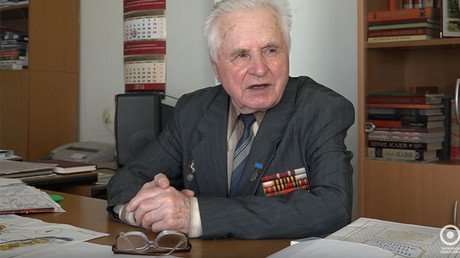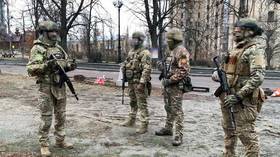‘30 seconds to film’: Last Soviet WW2 cameraman shares surreal frontline experience with RT
Boris Sokolov is said to be the only cameraman that filmed with the Soviet Army during World War II still living. He sat down with RT to talk about the challenges and technical limitations they faced filming on the frontlines, where one in five cameramen died.
The 97-year-old war veteran and honored Russian cameraman spoke with RT war correspondent Roman Kosarev ahead of the 72nd anniversary of the victory over Nazi Germany.
“There were 256 Soviet cameramen in total on the frontlines during that war. A fifth of them died,” Sokolov said.
Unlike modern war correspondents, who are considered non-combatants and are protected by the Geneva convention, as well as by helmets and vests emblazoned with “PRESS,” frontline cameramen at that time didn’t have any protection and had to rely on their own wits and luck.
“We did not have any protection, save for our head,” Sokolov said. Neither did they usually have weapons, save for a pistol, he added. In any case, they had their hands full with the Soviet equivalent of Eyemo cameras that weighed about 3.5 kilograms (7.7lbs).
“A helmet would hinder the filming process, it didn’t allow you to nestle the camera against your face. No one safeguarded us. It was only our enthusiasm and professionalism that forced us to subdue fear and film everything we found necessary. Our main weapon was the camera,” he added.
Besides the battlefields of World War II, known in Russia as the Great Patriotic War, Sokolov captured numerous landmark events of historic importance. He was in Berlin when the Soviet flag was raised over the Reichstag, and was working when Nazi commanders signed the unconditional surrender documents.
Visiting prisons in Poland and Germany, the cameraman filmed torture chambers equipped with guillotines, where Nazi top brass suspected of attempting to assassinate Hitler had been tortured and killed. Some of that guillotine footage was later used in a movie shot by renowned Soviet Russian director Andrey Tarkovsky.
After the war, Sokolov traveled the world with Soviet leaders, and even accompanied Khrushchev on his tour of the US, where he witnessed the famous shoe banging incident at the UN General Assembly meeting in New York in 1960.
However, it is his experience on the frontlines of WWII that the veteran cherishes the most.
“The modern-day generations see the truth of that war through our eyes,” Sokolov told RT.
30 meters of film & 30-second ‘battery life’
Those filming with the Red Army on World War II battlefields were not just cameramen; they did what a whole team of people is responsible for today, he said. Even while filming, they had to mentally plan the scripts and editing of their footage.
“It is very difficult to compare the work of cameramen back then and the job of professionals working in warzones now. Technology has advanced tremendously. Compared to current possibilities, we filmed in the stone age,” Sokolov said, adding that modern-day operators are blessed with not having to worry about the length of the film.
The “SK” cameras which Sokolov and his Soviet colleagues used were loaded with 35mm film spools that were 30 meters (98 feet) long, amounting to one minute of screen time. However, the cameras needed to be wound up mechanically like a clock after every 30 seconds of filming.
The limitations meant that the spectacular shots of nearby explosions seen in historical footage were often staged in-between the battles, except for in cases of sheer luck. The cameras recorded no sound either. However, the brutal reality of war was apparent from the injured and fallen soldiers captured in the picture frame.
“We had to adapt to the conditions of war and, at the same time, we aimed to capture those moments in a spectacular way so that they would be interesting to watch,” Sokolov said.
“When I was filming, I didn’t think about the historic value of the work, which it has today. My whole thought was occupied with how to better affect viewers of that time. We really tried to strengthen the well-known slogan “Everything for the front! Everything for Victory!”and filmed moments that could raise patriotic spirit,” Sokolov said.
The cameras of those days could only film in daylight, while the spools could only be reloaded in the dark. Cameramen had no equipment with which to edit their footage, and sent it to Moscow for further processing.
The surrender of Berlin was one of the most memorable moments for the veteran.
“I thought that it was the end, that the suffering would stop, and there would be no more war. I was mistaken. In two months, I was back on the frontline, filming in the Far East [as World War II continued against Japan]. And then, I can’t even name a time in history when there have been no wars. Look at our world today… We need to make an effort and do all we can to avoid the horrors of war,” Boris Sokolov said.















